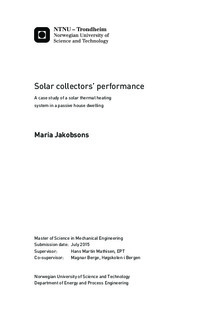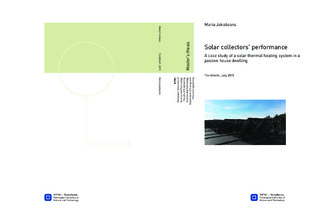| dc.description.abstract | This study examines a solar thermal heating system consisting of evacuated tube collectors used for combined space heating and heating of domestic hot water. The investigated system belongs to one of the passive house dwellings of Løvåshagen housing cooperative, located in Bergen, Norway. Since the beginning of its operation in 2008, preliminary measurements suggest that the solar collectors are not performing as well as initially intended. The objective of this thesis was to determine potential faults and weaknesses, concerning both the design and the operation of the system, and to contribute to increased solar utilization.
For this purpose, the functioning and performance of the investigated system was studied. This was achieved by collecting and processing measured data that was available in relation to an ongoing study. In addition, a simulation model of the investigated system was created in Polysun. By comparing simulated results with measured results, an outline of the present system performance was established. Furthermore, a parametric study was performed on the simulation model, in which the influence of various design- and operation parameters on system performance was examined. The investigated parameters included collector area, inclination angle and orientation angle of the collector, tank size, insulation of pipes and tank, volumetric flow rate, as well as parameters related to the control of the system and the extent of shading. This examination provided a basis for suggesting several improved scenarios that each targeted different components. By combining these scenarios in different ways, the best possible system configuration could be obtained.
It was found that the examined system is far from achieving its initial design goals of an annual solar fraction of 47%. In 2014, the measured solar fraction was only 10,8%, whereas the corresponding simulated solar fraction was 14,3%. With the current design and operation, the monthly energy savings are minimal - even during the high-radiation periods -, thus the benefit of having solar collectors installed on the roof seems questionable. However, the results from the parametric study revealed that by correcting and improving certain design and operation parameters of the investigated system, a simulated solar fraction of almost 43% could be achieved. Even by making just a few alterations assumed to be easy and relatively inexpensive to implement, a simulated annual solar fraction of approximately 29% was obtained. Other than shading caused by nearby collectors, the most essential parameters appear to be the those related to the control of the system, as well as tank design and switch-on temperature of the auxiliary heating element.
It can be concluded that though the potential for increasing the solar utilization is considerable, any alterations must be evaluated according to additional costs. Moreover, the results demonstrate the importance of thorough research and mapping of the potential performance-reducing factors, already during the design phase. Shading by means of nearby collectors is an especially important aspect to consider. This can be achieved with the help of proper simulation tools that include a shading simulator. Lastly, once the system is installed, it is equally important to ensure proper monitoring and control of the functioning of the system. | |

